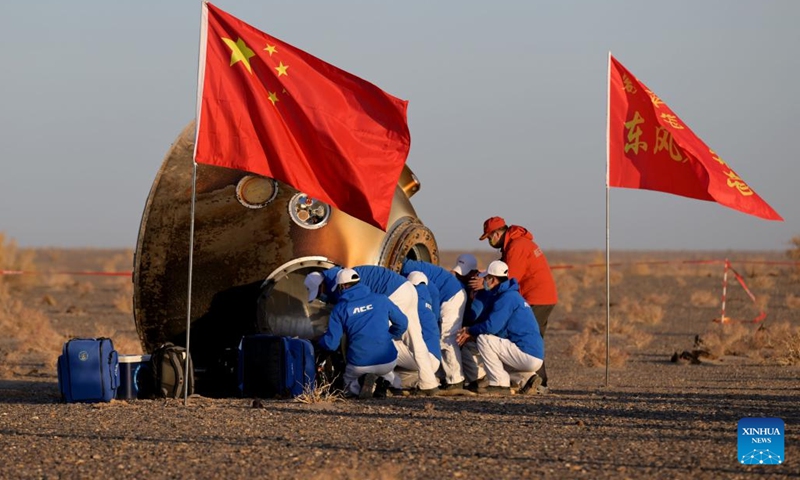The return capsule of the Shenzhou-16 manned spacecraft has successfully landed at the Dongfeng Landing Site as of 8:11 am on Tuesday, with the on-site medical team confirming that the taikonauts led by mission commander Jing Haipeng were in good health, which marked the resounding success of the first manned spaceflight mission after the China Space Station entered its application and development stage and lasted for 154 days in space.
The three taikonauts of Shenzhou-16 mission safely and smoothly exited the return capsule in good health by 9:10 am on Tuesday,per the China Manned Space Agency (CMSA.)
Jing, after exiting the return capsule, described the 154-day work and stay in space as “a happy and highly efficient” one when he came out of the capsule.
Zhu Yangzhu, one of the Shenzhou-16 crew, who participated the mission serving as Chi-na’s first spaceflight engineer, said after evacuating from the return capsule that he hopes to recover soon to join future space mission again.
Gui Haichao, the country’s first civilian taikonaut who served as the payload expert in the Shenzhou-16 mission, disclosed after landing that all the experiment and researches in space went well.
The CMSA told the Global Times on Tuesday that the mission carries great significance as all the three types of taikonauts have passed flight assessments and practical tests during the mission, which lays a solid foundation for the future development of the program and large-scale space science experiments.
The three taikonauts will return to Beijing later on Tuesday.
Global Times learned from the CMSA that at 7:21 am on Tuesday, the Beijing Aerospace Flight Control Center issued a return command through the ground control station, and the Shenzhou-16 manned spacecraft’s orbital module successfully separated from the return capsule.
Subsequently, the spacecraft’s return propulsion engine was ignited, the return capsule separated from the propulsion module, and the return capsule landed successfully. The search and rescue team responsible for the mission promptly identified the landing site and arrived on the scene.
The Shenzhou-16 manned spacecraft was launched into space on May 30, 2023, from the Jiuquan Satellite Launch Center and docked with the space station combination.
As the first batch of taikonauts to carry out the manned spaceflight mission at the space station’s application and development stage, the three taikonauts stayed in orbit for 154 days, the CMSA said.
During this period, they carried out one extravehicular activity and China’s fourth space class. They also assisted in multiple cargo egress missions from the space station, laying the groundwork for the routine implementation of space station missions.
This mission marks China’s first manned flight in the application and development phase of the manned space program.
With close cooperation between the taikonaut crew and ground research staff, numerous space science experiments were conducted in areas such as ergonomics, space medicine, life ecology, biotechnology, material science, fluid physics, and space technology.
Significant progress was made in the fields of space life science and human research, mi-crogravity physics, and new space technologies. This mission signifies an important step in the transition of China’s manned space program from construction to application and from investment to returns, the CMSA hailed.
(Global Times)




